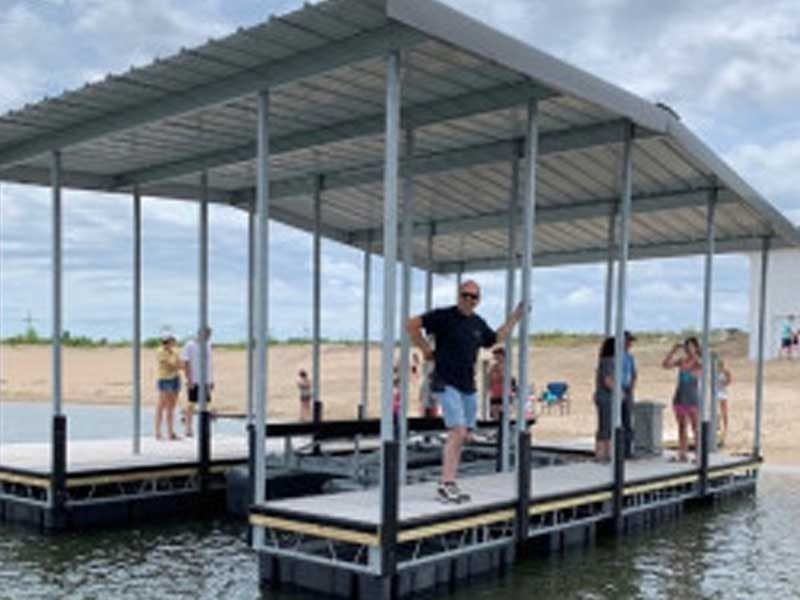Floating Docks: The Perfect Choice for Versatile Water Accessibility
Floating docks present a compelling remedy for a variety of water accessibility requires, providing flexibility that transcends conventional mooring options. The modular nature of floating docks helps with customization, providing to particular requirements.
Advantages of Floating Docks
Floating docks deal various advantages that boost water access for numerous applications. Their capability to fluctuate with altering water levels makes them especially beneficial in settings with changing tides or seasonal variants. This adaptability ensures that vessels can quickly moor without concern for the water's deepness, providing a reputable system for leisure, business, and industrial usages.
In addition, floating docks are frequently created from resilient products that resist rust, making them suitable for long-lasting usage in marine atmospheres. Their setup is typically less intrusive than traditional fixed docks, reducing the environmental impact and assisting in quicker release (floating docks). This adaptability enables simpler relocation or reconfiguration according to individual demands or ecological adjustments
Safety is another key advantage; floating docks can supply steady gain access to for individuals boarding or disembarking from watercrafts and lower the threat of mishaps connected with unsteady surfaces. They can be designed to suit a range of devices, such as cleats and fenders, boosting capability. Generally, floating docks stand for an efficient solution for boosting water gain access to across varied fields while promoting safety and ecological sustainability.

Kinds of Floating Docks
Different kinds of floating docks satisfy different requirements and settings, each designed with certain attributes to optimize performance. One of the most common types consist of modular docks, which include interlocking sections that permit very easy personalization and development. These docks are excellent for recreational use, as they can be customized to fit numerous boat sizes and water problems.
An additional popular choice is the stationary floating dock, which remains anchored in location yet drifts with changing water levels. dock company. This kind is particularly suited for areas with very little tidal changes, giving stable access for fishing or swimming. Furthermore, there are drive-on docks, which feature a sloped layout that permits watercrafts to conveniently drive on and off, making them suitable for personal watercraft and smaller vessels
For commercial applications, heavy-duty floating docks are available, constructed from reinforced materials to withstand significant loads and severe marine environments. Lastly, environment-friendly floating docks utilize lasting products and layouts to decrease ecological effect, commonly integrating functions like greenery to support local wild animals. Comprehending the numerous kinds of floating docks guarantees that individuals can pick the most appropriate option for their particular demands.
Setup Refine Summary
An effective setup of floating docks requires mindful planning and focus to detail to make certain you could look here ideal performance and security. The initial action entails examining the site problems, including water depth, existing, and prospective barriers. This evaluation educates the selection of the proper dock materials and style tailored to the certain environment.
Next, getting required authorizations is essential, as numerous territories have policies concerning construction on water bodies. The installation can proceed once permissions are secured. Begin by preparing the structure, which may involve anchoring systems or pilings customized to the dock type and neighborhood conditions.
Complying with the foundation arrangement, put together the dock sections according to maker requirements. Ensure that all components are safely attached and straightened read the article to withstand environmental anxieties. Placement the dock in the marked location, ensuring it is level and steady.

Upkeep Tips and Finest Practices
After the setup process is complete, recurring upkeep plays a crucial function in making sure the durability and capability of floating docks. Regular inspections need to be performed to determine any indicators of degeneration, damages, or wear - floating dock company. Inspect for any kind of loosened installations, fractures, or splitting up in the dock sections, as these can compromise architectural stability
Cleansing the dock is necessary to eliminate particles, algae, and other accumulation that can affect its look and safety. Make use of a gentle stress wash regularly to keep tidiness without creating damage to the surface area. Additionally, applying a safety sealant every few years can aid enhance durability and stand up to environmental wear.
Take note of the mooring lines and anchors, ensuring they are complimentary and safe and secure from rust. Change any kind of degraded elements without delay to avoid dangers. Seasonal changes may also be needed; throughout extreme climate condition, visit site reinforcing the dock or repositioning can protect against damages.
Applications for Floating Docks
Floating docks offer a plethora of applications, satisfying both industrial and leisure demands. In entertainment settings, they offer smooth accessibility to rivers for tasks such as boating, fishing, and swimming. Their adjustable nature permits setup in varying water degrees, making certain stable and risk-free access despite tidal changes.
Readily, floating docks are vital for marinas and beachfront organizations. They promote the docking of vessels, making it possible for reliable unloading and loading of items. Their modular layout enables very easy development or reconfiguration to suit altering service demands, making them suitable for watercraft leasings, trip operations, or fishing charters.
Additionally, floating docks are utilized in environmental applications such as marine study and environment repair. They can function as platforms for scientific studies, checking water top quality, or carrying out wildlife studies without disturbing sensitive environments.
In industrial contexts, floating docks are employed in construction projects, providing accessibility to hard-to-reach areas for tools and personnel. Their adaptability, sturdiness, and very little effect on the atmosphere make them an optimal selection for a large range of applications, boosting both performance and accessibility in numerous water-based environments.
Verdict
In verdict, floating docks represent an optimal remedy for diverse water access needs, owing to their adaptability, sturdiness, and modular style. Floating docks offer as a beneficial property for recreational, business, and ecological jobs, ensuring dependable access to waterways and promoting sustainable practices in aquatic environments.
Floating docks existing an engaging option for a range of water access needs, providing adaptability that transcends conventional mooring choices.Floating docks deal numerous benefits that boost water gain access to for different applications. Generally, floating docks stand for a reliable option for enhancing water access across varied markets while promoting safety and environmental sustainability.
An additional prominent choice is the stationary floating dock, which continues to be anchored in place yet drifts with changing water levels.In final thought, floating docks stand for an optimal remedy for varied water gain access to needs, owing to their flexibility, durability, and modular layout.